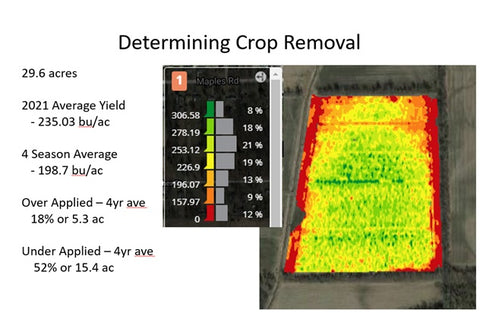Crop Removal Soil Fertility Done Right
For rented cropland, applying phosphorus and potassium fertilizer based on crop removal is common and simple, or so it seems. Theoretically if you apply as much nutrient as is removed in the harvest of grain and/or biomass, soil fertility levels should remain steady. This works well in a cash rent scenario. The soil fertility is maintained at over time for the landowner, and the tenant farming the land is not building up a soil fertility that they may not have access to in the future.
The crop removal fertilizer rate is calculated by multiplying the yield times the nutrient removed per unit of yield. Often this is done without routine soil testing to keep input cost down, further compounding potential issues. Actually, there are three main inputs into the crop removal fertility methodology, the crop removal factor, yield, and soil test values. Let’s look at how each factor can impact the results of a crop removal soil fertility plan.
Often book values are used for crop removal factors, these tend to be slightly higher than actual crop removal in many cases. The nutrient removed per unit of grain can vary quite a bit, biomass harvesting can vary even more. Most book values are identified so that 2/3 to 3/4 of all the values in the dataset fall below the single published value. In most cases using book values for crop removal factors will slightly overestimate the actual crop removal, this helps avoid a short fall in fertilizer application rates. For corn the nutrient removed per bushel often declines with increasing yields. When corn yields increase because of a larger corn kernel, the majority of that kernel is starch comprised of carbon, hydrogen, and oxygen. The germ of the kernel that contains nutrients like nitrogen, phosphorus, and potassium stays relatively the same size. This reduces the concentration of nitrogen, phosphorus, and potassium in the grain. Crop removal can also be impacted by growing conditions and variety. To improve the accuracy of the crop removal values, biomass and grain samples can be sent to the lab for analysis.
The value used for the yield input can be the source of the greatest errors. Yield is not defined in soil fertility calculations as past measured yield or future predicted yield. Measured yield is usually more accurate than predicted. Often the field average yield or an average of several past years of yield are used for this value. This assumes that the yield is stable from year to year and that the yield is uniform across the field. Often this is not the case. The picture below is a simple example of both issues. This field has a 4-year running average of 198.7 bpa corn, and a realistic yield goal of 200 bpa corn. However, in 2021 the field average yield was 235 bpa. If 200 bpa was used in the calculation, the calculated fertilizer rate could be 15% under actual average crop removal. For this same field if a uniform 200 bpa was to be used, 18% of the field would receive more fertilizer than was removed, and 52% would receive less fertilizer than was removed. Using a flat yield value would lead to excessive fertilizer inputs for the low yielding areas and put the high yielding regions at risk for lost yield potential. While arguments can be made about the accuracy of yield maps, they will identify regions of above average and below average yields. There is an application for variable rate fertilizer application even in a crop removal fertility program.

While soil tests are often seen as a way to predict or prescribe fertilizer application rates, they can also help monitor changes or the results of the fertility management. Soil testing this field after many years of flat rate crop removal revealed that the low yielding areas of the field did not require any fertilizer and the high yielding areas of the field had very low soil fertility levels. Soil fertility maps can be used in conjunction with yield maps to further define fertilizer application rates in a variable rate crop removal fertility plan.



